Nowadays, rapid advances in medicine have enabled us to enjoy a significant increase in life expectancy and quality of life. However, cancer remains a disease that affects a large number of people. According to the World Health Organization (WHO), it is the second most fatal disease (source).
Prevalence of Cancer in Europe
As revealed by the European Commission data, although Europeans make up only one-tenth of the world’s population, around 25% of all cancer cases reported each year occur in this continent. Cancer is the leading cause of death among Europeans under 65, and data shows that only half of the population of Europe will avoid a cancer diagnosis.
Overall Cancer Incidence
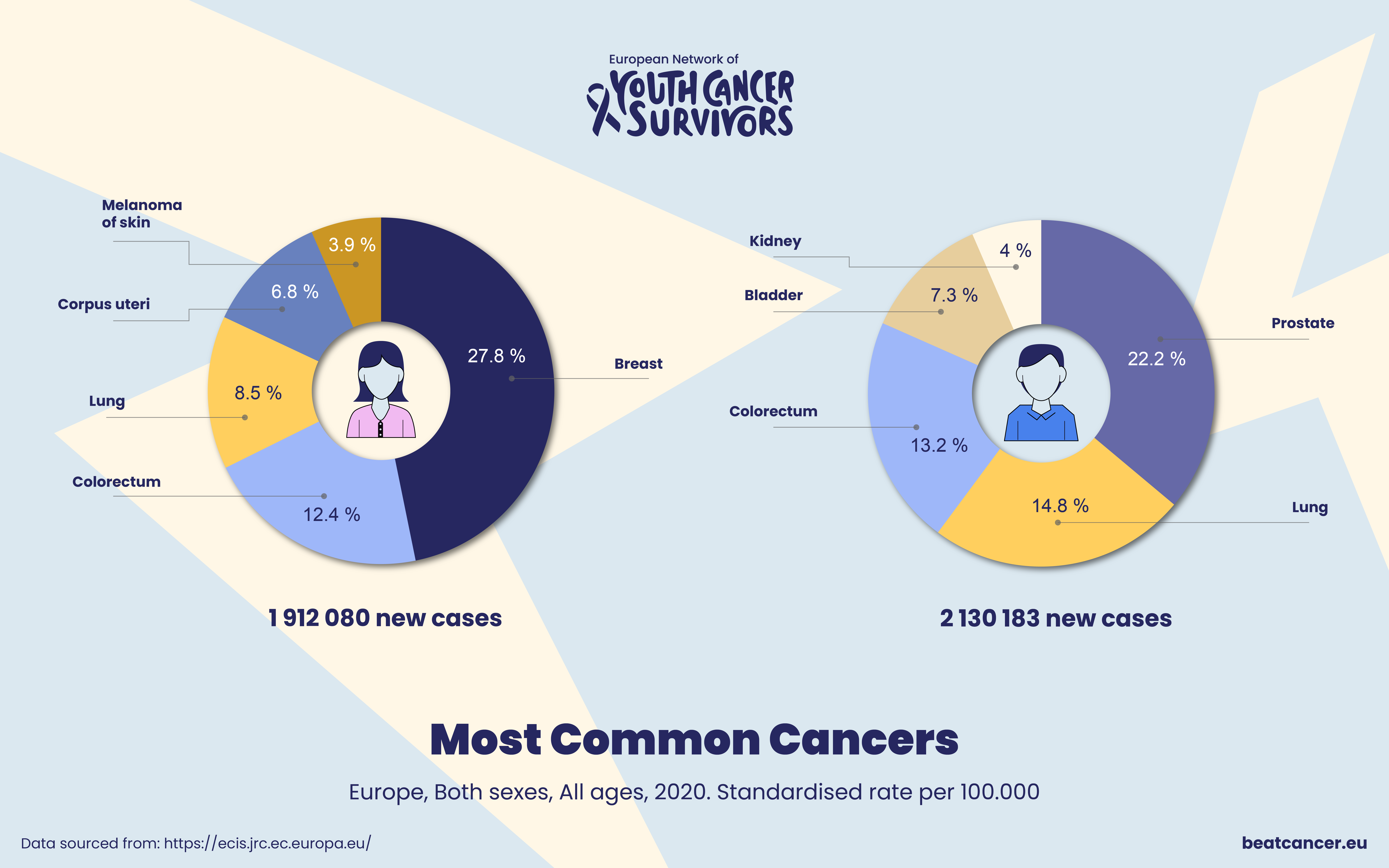
In 2020, according to the European Commission, Europe witnessed around four million new cancer cases (source), of which 1.9 million were diagnosed in women and 2.1 million in men (source).
Most Common Types of Cancer

Breast cancer is the most commonly diagnosed type of cancer both in Europe and worldwide (source). Breast cancer symptoms can vary widely, but it is estimated that this type of cancer accounted for 13.14% of all cancer cases reported in Europe in 2020. This is followed by colorectal cancer (12.86%), lung cancer (11.81%), prostate cancer (11.71%), and bladder cancer (5.05%).
Age and Gender Distribution of Cancer Cases
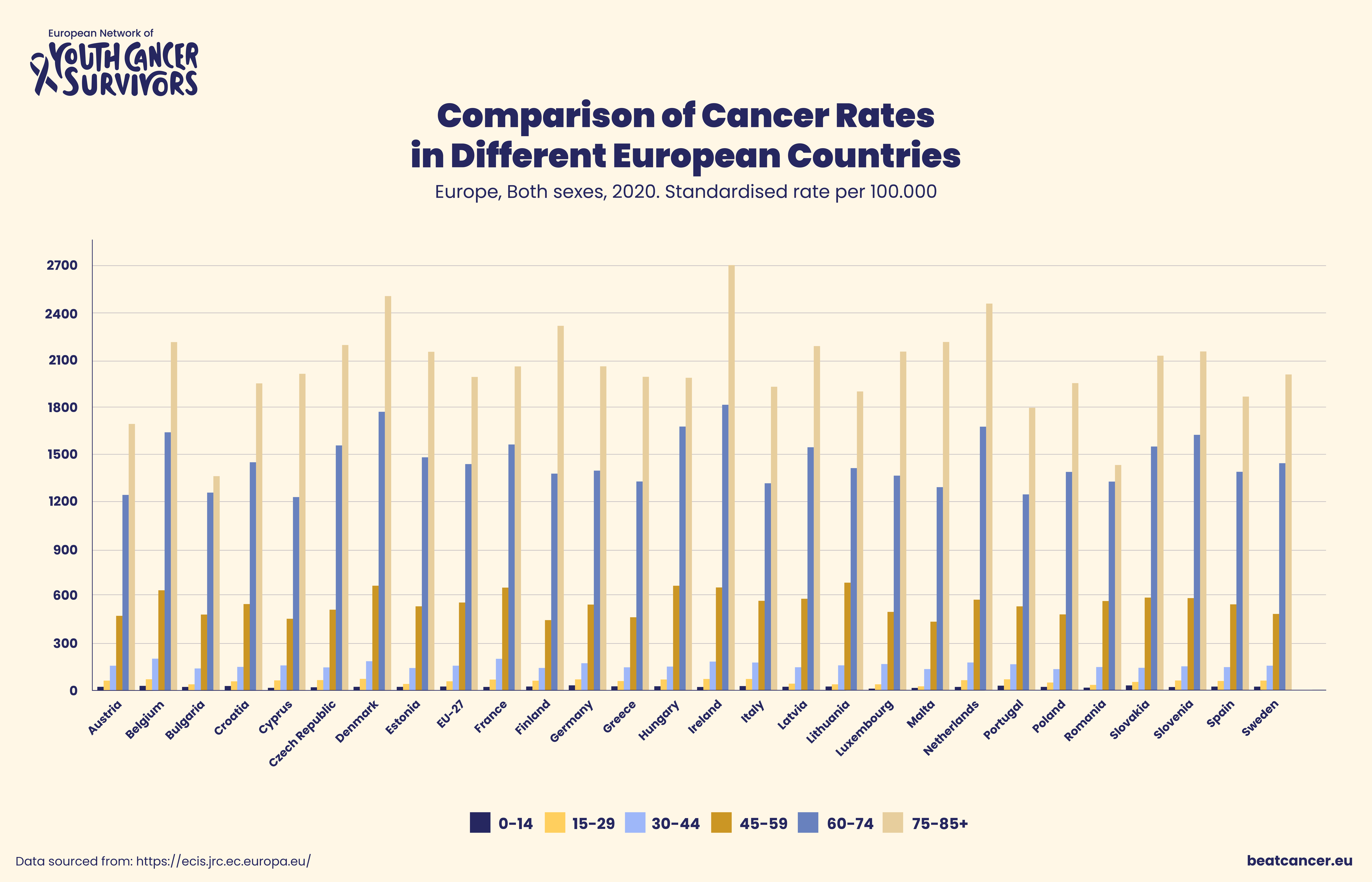
The most common age of cancer diagnosis is 65 years and older. It is estimated that 60% of people in this age group are diagnosed with cancer (source). Meanwhile, experts at the Joint Research Centre, who have studied the impact of ageing of population on the incidence of cancer, predict that the number of people with cancer, compared to 2020, will increase by 21% by 2040 (source).
People in the 65+ age group have the highest prevalence of colorectal (15%), prostate (14%), lung (12.8%), and breast (10%) cancers. In other age groups, breast cancer is the most commonly diagnosed: 22.6% in girls/women aged 0-44 years and 16.7% in girl/women aged 45-64 years. (source).
Analyzing cancer incidence by gender reveals that colorectal and lung cancers are among the five most commonly diagnosed types of cancer in both men and women. However, lung cancer is approximately 1.7 times less common in women than in men.
Women are most often diagnosed with breast cancer (27.8%), while men are most often diagnosed with prostate cancer (22.2%) (source).
Comparison of Cancer Rates in Different European Countries
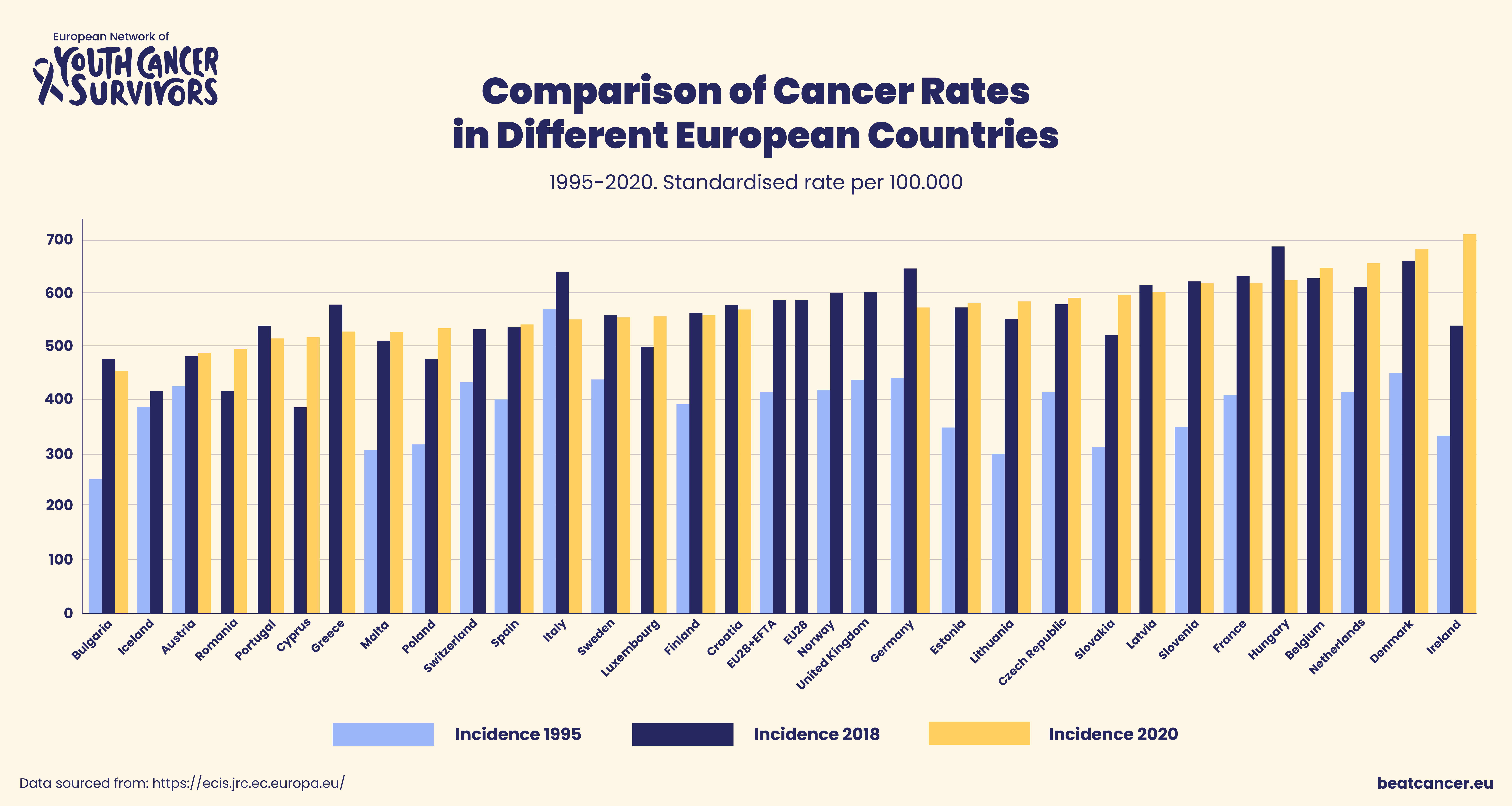
Overall, Ireland is estimated to have the highest number of cancer cases in Europe (718.3 per 100,000, i.e. +33% compared to the European average). Meanwhile, Latvia has the highest number of cancer cases among men (851.7 per 100,000, +28% compared to the European average) and Denmark the highest number of cancer cases among women (633.9 per 100,000, +38% compared to the European average).
The lowest cancer incidence rates in Europe for both sexes are recorded in Albania (351.6 per 100,000, -47% compared to the European average for men; and 213.4 per 100,000, -53% for women), Ukraine (489.3 per 100,000, -26%; and 314.7 per 100,000, -31%), and Moldova (542.1 per 100,000, -19%; and 310.9 per 100,000, -32%) (source).
Childhood Cancer Incidence in Europe
The European Society for Paediatric Oncology reports that cancer remains the leading cause of disease-related death in children over the age of one, claiming the lives of more than 6,000 children and adolescents each year. However, it is estimated that currently there are now almost 500 000 children in Europe who have recovered from cancer (source), and the overall childhood cancer mortality rate in EU countries has fallen by 2.8% in the period from 1990 to 2015 (source).
Incidence and Prevalence of Childhood Cancer Cases
Every year, 35,000 new cancer cases are diagnosed among children and adolescents in Europe. Cancer mortality in children in Eastern European countries is reported to be 20% higher compared to the rest of Europe (source).
Common Types of Childhood Cancers
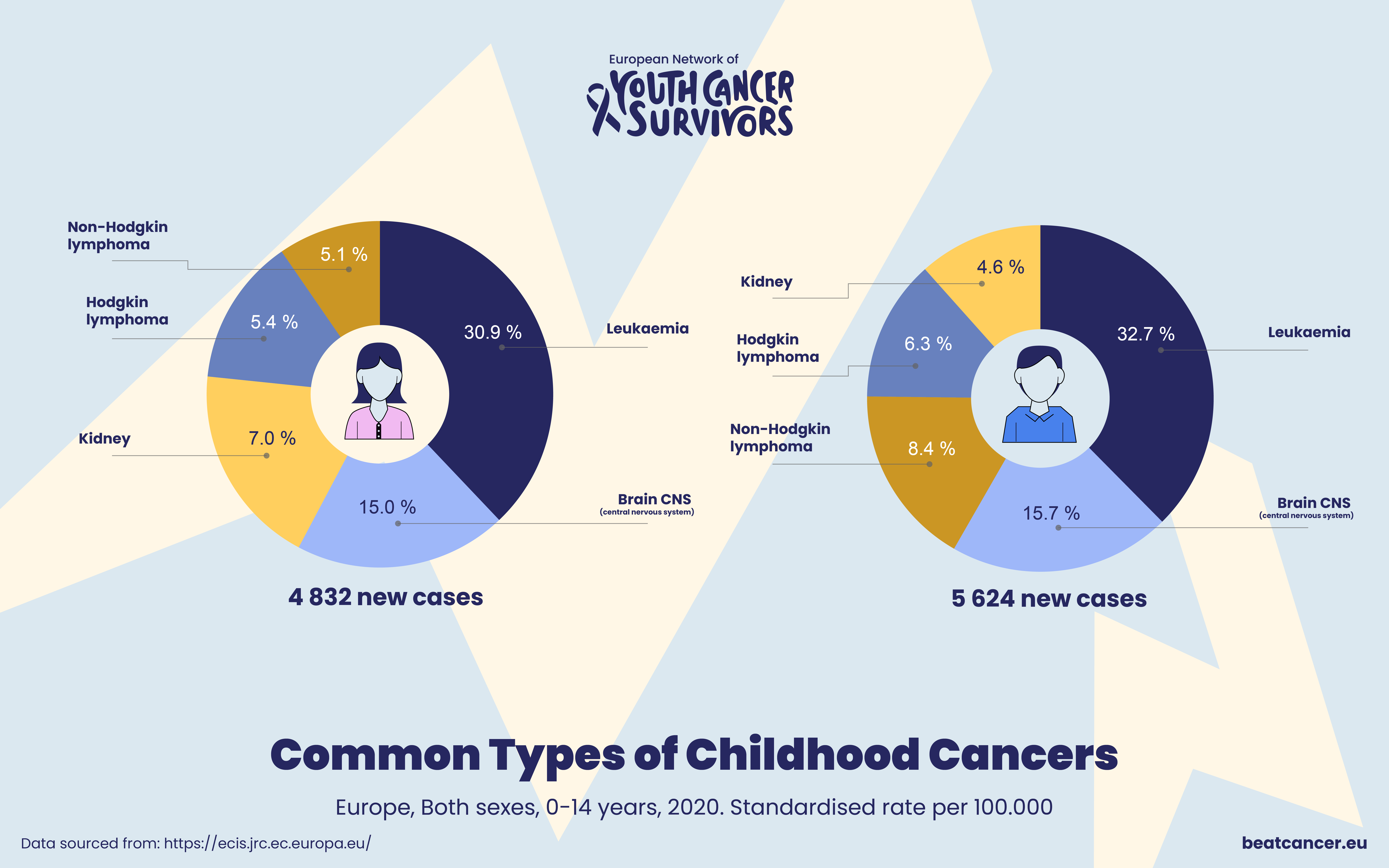
According to the European Society for Paediatric Oncology, the most common cancers in children are leukemia, neuroblastomas, Wilms tumours, brain cancer, rhabdomyosarcomas, lymphomas, retinoblastomas, osteosarcomas, and Ewing sarcomas.
Leukemia accounts for about 35% of all cancer cases. Brain cancer comes second. The incidence of this type of cancer is 15%. Wilms tumours accounts for 6-7% of cases; some children have genetic predisposition to develop it. Soft tissue sarcoma, which most often develops in the muscles, but can also develop in the head, neck, urinary tract or testicles, accounts for 5-8% of all cancers.
Neuroblastoma is less common, accounting for 5-7% of childhood cancer diagnoses. This type of cancer cells forms in the nervous tissue of the adrenal glands, neck, chest or spinal cord. Osteosarcoma and Ewing sarcoma are the most common malignant tumours of bone tissue in children, occurring in 6% of children who develop cancer.
Retinoblastoma accounts for 3-4% of all cases. The most common types of cancer also include lymphomas, categorised into Hodgkin and Non-Hodgkin lymphomas. (source).
Age and Gender Distribution of Childhood Cancer Cases
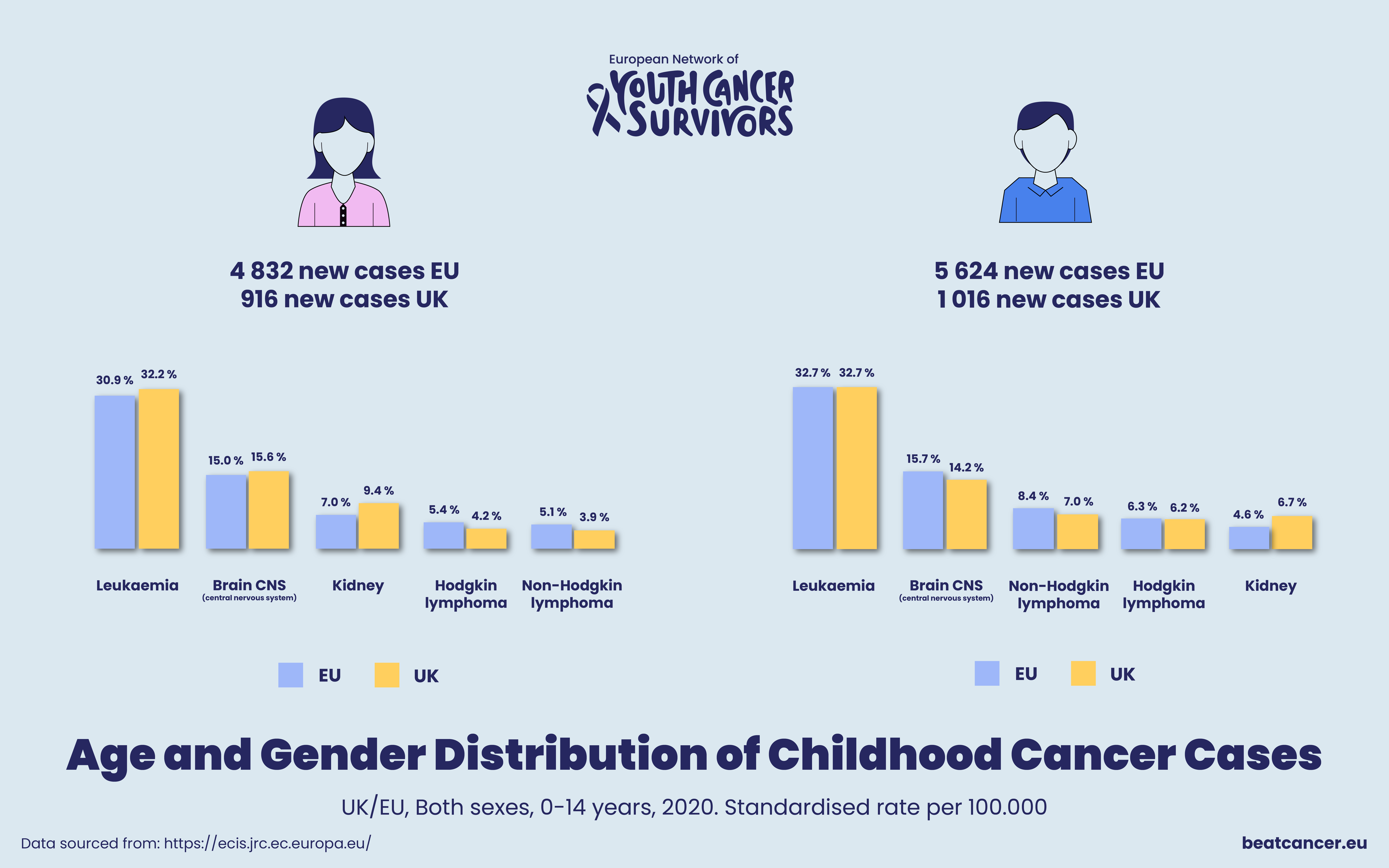
Leukemia, the most prevalent type of cancer in children, is most commonly diagnosed in children under 10 years of age. The two main types of childhood brain tumours are gliomas and medulloblastomas. Type 1 tumours are diagnosed in children with an average age of 6 years, while the majority of medulloblastomas occur in children under 10 years. Wilms tumour is most commonly diagnosed in children under 5 years of age; however, aprox. 8 out of a million children under the age of 14 are also diagnosed with this type of cancer.
Neuroblastoma and retinoblastoma are also most commonly diagnosed in children under 5 years of age; while osteosarcoma and Ewing sarcoma are mostly diagnosed in children and young people aged 10-20 years.
Rhabdomyosarcoma is most common in children and young people aged 2-6 and 15-19 years, while Hodgkin disease is most common in people aged 15-40 years (source).
In 2016-2018, in the UK, leukemia (32%), brain and spinal tumours (25%), lymphoma (13%), soft tissue sarcoma (7%) and neuroblastoma (6%) were the most common diagnoses in boys under 14. Among 15-24 year old boys and men, the most common tumours are germ cell tumours (25%), lymphoma (21%), carcinoma and melanoma (18%), brain and spine tumours (12%), and leukemia (10%).
Girls aged under 14, similar to boys of the same age group, were most commonly diagnosed with leukemia (31%), brain and spinal tumours (26%), lymphoma (7%), neuroblastoma (6%), and kidney tumours (6%). Almost half of the cases in girls and women aged 15-24 years were carcinoma and melanoma (43%), lymphoma (20%), tumours of the brain and spine (13%), and leukemia (8%). However, compared to boys and men aged 15-24 years, five times fewer cases of germ-cell neoplasms (5%) were recorded in girls of the same age group (source).
Comparison of Childhood Cancer Rates in Different European Countries
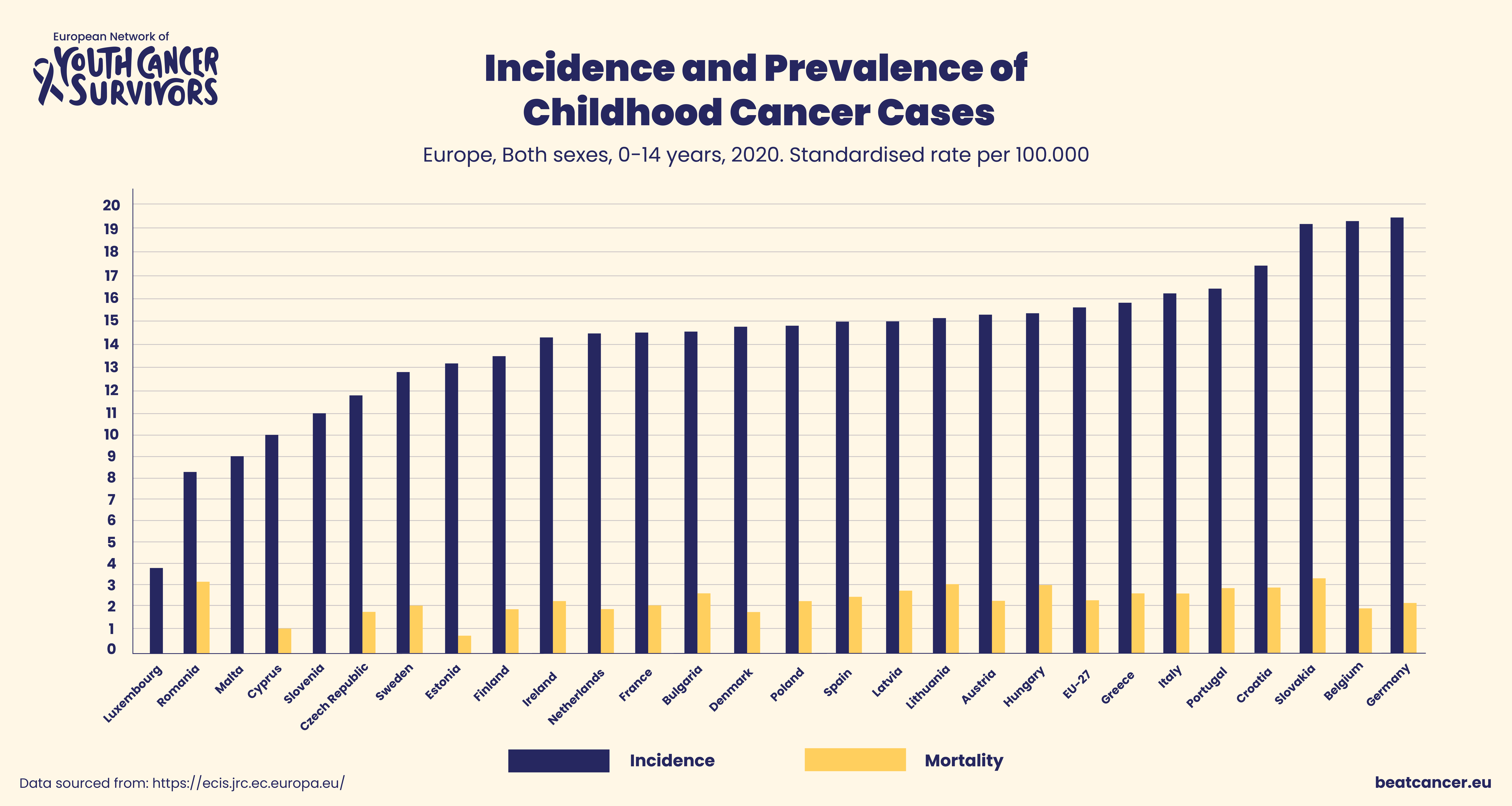
Comparing cancer incidence rates from 2010 to 2012 in different European countries, all countries except Latvia, Norway and Romania have the highest prevalence of leukemias, myeloproliferative diseases, and myelodysplastic diseases in children under 14. The highest incidence of these types of cancer was recorded in Greece (56.53%), Cyprus (47.83%), and Lithuania (38.87%), while the Czech Republic (23.75%), Latvia (23.83%), and Belgium (25%) had the lowest rates.
CNS and miscellaneous intracranial and intraspinal neoplasms are also among the most common types of cancer. The highest incidence of this type of cancer was witnessed in Greece (30.41%), Iceland (29.63%), and Norway (29.46%), while Bosnia and Herzegovina (5.26%), Cyprus (8.70%), and Ukraine (15.68%) had the lowest incidence.
Lymphomas and reticuloendothelial neoplasms) are as well among cancers with the highest incidence. This type of cancer was most prevalent in Bosnia and Herzegovina (18.42%), Romania (16.67%), and Latvia (15.42%), while the lowest incidence thereof was seen in Cyprus (8.70%), Iceland (9.26%), and Lithuania (9.40%) (source).
Risk Factors and Causes of Childhood Cancer
According to the WHO, there are still there is still no definitive explanation for why children get cancer. Available evidence suggests that around 10% of children with cancer have a genetic predisposition to the disease.
However, certain chronic infections, such as HIV, Epstein-Barr virus and malaria, can be considered risk factors. Meanwhile, other infections can increase child’s risk of cancer in adulthood, so it is important to get vaccinated against hepatitis B, as this vaccination helps prevent liver cancer, and against human papillomavirus, which can help prevent cervical cancer (source).
Conclusion
In conclusion, the data underscores the significant impact of cancer on the European population. While medical advances have improved life expectancy and quality of life, cancer remains a major health concern. It is the second leading cause of death in Europe, affecting a quarter of the continent’s population each year.
The statistics reveal the most common cancer types, with breast cancer leading the way, followed by colorectal, lung, prostate, and bladder cancers. Age and gender play a crucial role in cancer prevalence, with older adults facing a higher risk. The projections suggest a 21% increase in cancer cases by 2040 due to the aging population.
Childhood cancer is also a concerning issue, with leukemia, brain cancer, and Wilms tumors among the most common diagnoses. Despite the challenges, there has been progress in reducing childhood cancer mortality in European Union countries.
The data highlights variations in cancer rates across European countries, with some nations experiencing significantly higher incidence rates than others. These differences may be attributed to a range of factors, including genetic predisposition and environmental influences.
Overall, the data underscores the importance of continued research, prevention strategies, and access to advanced medical care in addressing the complex challenges posed by cancer in Europe, both among adults and children. Efforts to reduce risk factors and promote early detection are critical in the fight against this pervasive disease.









Comments
Thank you. Comment sent for approval.
Something is wrong, try again later